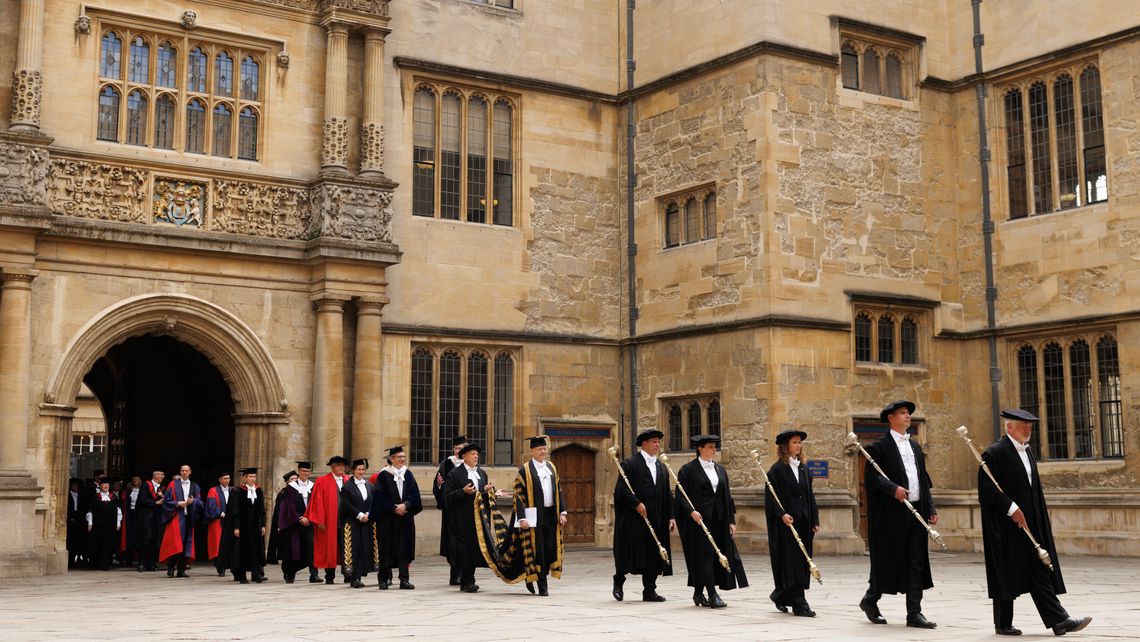Oxford’s famous skyline has some newcomers among its dreaming spires. The university has opened two epic developments: the Schwarzman Centre for the Humanities, with a 500-seat concert hall, and the Life and Mind Building, for the experimental psychology and biology departments. Each is at the architectural cutting edge. The additions mark another new chapter in Oxford’s nine-century history, during which it has become a global academic powerhouse.
Oxford has produced 56 Nobel prizewinners and is the alma mater of 31 British prime ministers including Sir Keir Starmer. It has claimed the title of University of the Year in the Southeast 2026.For undergraduates, the opportunity to learn from academics at the forefront of their field is a significant draw and worth the competitive admissions process — as many as 45.5 per cent of entrants achieve A*A*A* or better at A-level.
Instead of a campus, the university is made up of colleges spread across the city. Its gardens, libraries and museums hold 21 million objects, specimens and printed items.The student experience involves traditions like summer balls, black tie dinners and formal halls.
What is the University of Oxford’s reputation?
Oxford has slipped from 3rd to 4th in our table, where it ties with its ancient rival, Cambridge. The university is unsurpassed for its good honours, with 93 per cent of students gaining firsts or 2.1s. The tutorial system — weekly groups of two or three students discussing ideas in depth with their tutor — is a core feature. Oxford is fourth in our research quality index with a stellar set of results in the latest Research Excellence Framework (REF 2021), which rated 91 per cent of its submissions world-leading or internationally excellent. In global rankings, which take account of the research profile but not student reviews, Oxford has been ranked first in the world by Times Higher Education (THE) every year from 2017 to 2025. In THE’s subject rankings, Oxford has reigned unbeaten for computer science for seven years and has held the crown for clinical, pre-clinical and health subjects for 14 years — it earns the title of Medical School of the Year 2026.
The university achieved triple gold in the Teaching Excellence Framework (TEF 2023). However, feedback in the latest National Student Survey (NSS) hints of discontent: our new NSS analysis puts Oxford in 124th place for the broad undergraduate experience. Although it does much better for teaching quality, it has dropped 25 places to 44th.
What are the University of Oxford’s entry requirements — and my chances of getting in?
Oxford averaged the fifth-highest entry standards, with 197 Ucas points. The university does not make contextual offers but, like Cambridge, its admissions process takes an applicant’s background into account. Oxford invites only the strongest contenders to interview and does not enter clearing. For 2024 entry, Oxford had 23,061 applications, and 3,245 undergraduates were accepted. Typically, it gets seven applications per place, though this varies significantly. For example, economics and management is the most oversubscribed, with 19.1 applications per place closely followed by computer science (17.2). Music and theology are among the least popular. The fully funded Astrophoria foundation year, introduced in 2023, is aimed at talented UK state school students who have experienced severe disadvantage.
What are the graduate prospects?
The university ties with Cambridge in third place in our Graduate Outcomes survey analysis, based on 90.4 per cent of graduates being in highly skilled work or postgraduate study 15 months after finishing their course. Oxford's careers service works with more than 500 industry partners, generating over 1,900 exclusive work experience opportunities each year. The university’s internship programme offers global opportunities between terms, and the longer postings are often funded.
What is the University of Oxford’s campus like?
The picture-postcard image of Georgian courtyards, gothic spires and baroque porticos of the university colleges defines the city centre. This character, along with landmarks such as the Radcliffe Camera, part of a network of libraries that include the renowned Bodleian, makes the city a tourist destination, as well as a historic seat of learning.
The Schwarzman Centre for the Humanities, which is due to open next month, was funded by a £185 million donation by the American financier Stephen A Schwarzman and is thought to be the largest building in the country to meet Passivhaus environmental standards. It will include seven of the university’s ten humanities departments. The departments of experimental psychology and biology have relocated to the Life and Mind Building which is part of a joint venture with Legal & General to provide £4 billion in funding towards the creation of world-class science and innovation districts.
The Old Power Station in Osney will reopen in 2025 as the Global Leadership Centre, providing a teaching and residential base for the Saïd Business School. It adds to the opening of the Science Area’s biochemistry building in 2021, and the Institute of Developmental and Regenerative Medicine in 2022.
When can I visit?
How does the college system work?
Oxford is part of the Ucas system but there are significant peculiarities to applying. The deadline is much earlier than for most other universities: October 15th. You can apply to either Oxford or Cambridge in any one year, but not both. Selection is in the hands of individual colleges, not the university.
Your first campus is your college, and they vary considerably in atmosphere and student mix. Brasenose had a state school intake of 80.3 per cent across the years from 2022-24 (including grammar schools); at Pembroke the proportion was 55.6 per cent. At Christ Church, 34.7 per cent of its intake came from black or ethnic minority backgrounds in the same three-year period compared with 22 per cent at Merton.
Most candidates apply to a specific college, although open applications can be made if you are happy to go to any college. Candidates are often pooled to other colleges. All shortlisted candidates are invited to interview.
Everything you need to know about the University of Oxford’s student life and wellbeing support
Oxford’s short eight-week terms mean that student life may be likened to a series of sprints. The university expects all students to study for at least 40 hours a week. A work-hard, play-hard attitude prevails, sport and drama are particularly competitive and ambitious but there are 400 societies and clubs to choose from offering a community for any interest from archery to ultimate Frisbee.
Student media is well resourced and there are opportunities to contribute to the weekly student newspapers: Cherwell and the Oxford Student or broadcast live on Oxide Radio. The Oxford Union is the university’s most famous and prestigious society, hosting world-famous speakers year-round for a lifetime membership fee of £343.
The Iffley Road sports complex has an athletics track, a pool and three gyms. With nearly 80 sports clubs to choose from and collegiate teams, Oxford performs well against other universities, reaching 14th place in the latest British Universities and Colleges Sport (Bucs) overall points table.
Cafés and pubs spill into the newly pedestrianised streets in the evenings, but the number of late-night venues in the city has been diminishing, the student favourite Atik closed down last summer. Cold water swimming is on the up among Oxford students, who swim at Port Meadow and the pool in Hinksey Park all year round, while every available inch of riverbank is covered by picnic blankets in high summer.
Colleges have invested more resources into their in-house support: hiring dedicated student support officers and rolling out peer support schemes where students are trained to listen to others and signpost services — including Peers of Colour and Rainbow Peers. There is also a peer-led sexual consent education programme — delivered as part of college induction weeks. One in eight students consult the university-wide counselling service, which offers one-to-one sessions, therapeutic groups and weekly workshops.
What do the students say?
“Oxford is a small city, but the perfect size for students, and you can get everywhere by bike or on foot. The work is challenging but rewarding, and everything happens against the incredible backdrop of the historic city, from the Radcliffe Camera to the ancient colleges. There’s lots of green spaces, which is great in the summer, and you’ll never run out of things to do, events to go to, or societies to try. Plus, you get some unique experiences like the summer balls, regular black tie dinners, formal halls, and other unusual traditions.”
Lottie Tellyn, PPE graduate
What about student accommodation at the University of Oxford?
Students live in college accommodation. Most can be housed for at least two years, if not the full duration of their degree. Rents vary by college, and while meals are taken in the dining hall, most colleges allow students to opt out and have basic self-catering facilities.
How diverse and inclusive is the University of Oxford?
The number of applicants accepted from state and independent schools is an enduring hot topic. In 2024, 66.2 per cent of Oxford’s UK undergraduates came from state schools (including selective grammars). Our social inclusion figures consider only the proportion from non-selective schools (51.6 per cent, placing Oxford 111th in England and Wales). Oxford is 111th out of 115 universities in England and Wales for social inclusion overall. It does better with its proportion of students from ethnic minorities (28.3 per cent, 61st) and its black awarding gap has narrowed to -7.6 per cent, sending it into 7th place.
Oxford's outreach programmes, such as UNIQ, aim to demystify the university experience and help talented students from underrepresented backgrounds gain admission.
There are also 250 places a year on the Opportunity Oxford bridging programme, an academic residential course during the summer before the student starts, designed to help prepare UK students from underrepresented groups who have an offer from Oxford.
Everything you need to know about scholarships and bursaries at the University of Oxford
Oxford spends more than £10 million a year on financial support to students from lower-income households, and about one in four students receives funding. UK students with household incomes up to £32,500 can become Crankstart Scholars, eligible for bursaries of up to £6,270 a year, funded internships, and volunteering opportunities. Students with household incomes of £50,000 or less qualify for an Oxford Bursary of £1,080 to £4,320 a year. Colleges often also have their own funds, such as travel grants, academic prizes and book grants.
Win a uni bundle with John Lewis
Times+ members have the chance to win one of five uni bundles including bedroom, kitchen and tech essentials courtesy of John Lewis. Enter here . T&Cs apply.






